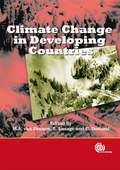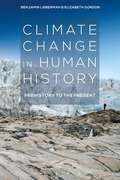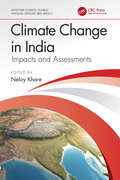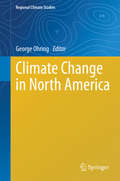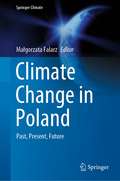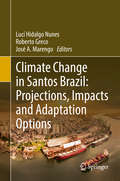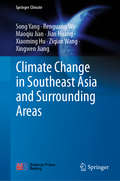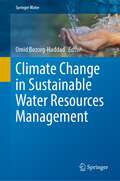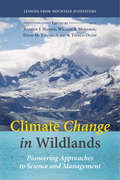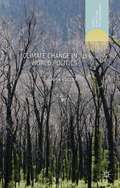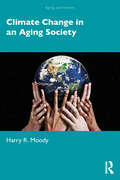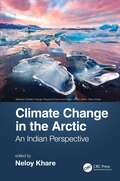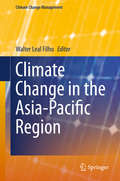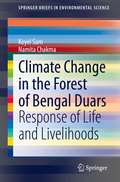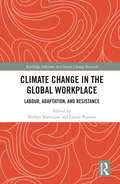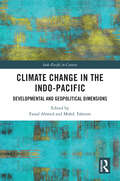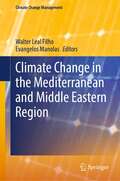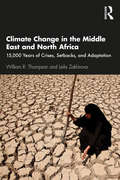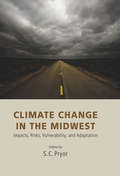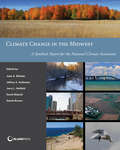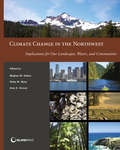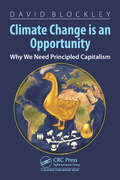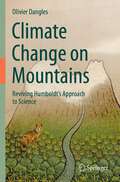- Table View
- List View
Climate Change in Developing Countries: Results from the Netherlands Climate Change Studies Assistance Programme
by R. Lasage C. Dorlands M. A. van DrunenThis book presents an overview of the studies conducted by the Netherlands Climate Change Studies Assistance program. The program was set up in recognition of the need for developing countries, in particular, to face the challenges confronting all countries under the UN Framework Convention on Climate Change. The book presents an overview of the main results in 13 countries: Bolivia, Colombia, Ecuador, Egypt, Ghana, Kazakhstan, Mali, Mongolia, Senegal, Suriname, Vietnam, Yemen and Zimbabwe. It provides a critical evaluation of the methodologies and approaches used, a cross-country synthesis and recommendations for further studies. Subjects dealt with include not only impact studies, but also vulnerability and adaptation, mitigation and climate related policy.
Climate Change in Human History: Prehistory to the Present
by Elizabeth Gordon Benjamin LiebermanClimate Change and Human History provides an up-to-date and concise introduction to the relationship between human beings and climate change throughout history. <P><P>Starting with periods hundreds of thousands of years ago and continuing up to the present day, the book illustrates how natural climate variability affected early human societies, and how humans are now altering climate drastically within much shorter periods of time. For each major period of time, the book will explain how climate change has created opportunities as well as risks and challenges for human societies. <P><P>The book introduces and develops several related themes including: <ul> <li>Phases of climate and history</li> <li>Factors that shape climate</li> <li>Climate shocks and sharp climate shifts</li> <li>Climate and the rise and fall of civilizations</li> <li>Industrialization and climate science</li> <li>Accelerating climate change, human societies, and the future</li> </ul> <P><P>An ideal companion for all students of environmental history, Climate Change and Human History clearly demonstrates the critical role of climate in shaping human history and of the experience of humans in both adapting to and shaping climate change.
Climate Change in India: Impacts and Assessments (Maritime Climate Change)
by Neloy KhareThe climate over the Indian subcontinent is influenced by complex interactions between the atmosphere, ocean, and land, along with human interventions that are influencing heat extremes, changing monsoon patterns, sea-level rise, and posing serious threats to lives and livelihoods among populations in India. This book, based on recent studies and research, explains how and why the climate is changing across India and how these changes are expected to evolve in the future. It takes a holistic view of the climate from India’s perspective and discusses important themes such as groundwater, land use, livestock, and natural disasters. Readers will have an in-depth understanding of impacts and possible adaptations.Features Includes case studies of groundwater and the effect of climate change. Identifies land use and land cover changes in different regions in India. Discusses the implications of past and present climate change on various livestock types. Explains various natural hazards and their relationship to climate change. Describes technological intervention in climate change. Researchers, academics, and graduate students in Earth sciences, climatology, meteorology, or environmental studies working on projects related to climate change will find this an invaluable reference. Governmental organizations, institutions, and global NGOs will also benefit from the insights presented in this book.
Climate Change in North America (Regional Climate Studies)
by George OhringThis book describes thoroughly the North American Climate of the past 65 million years, with special emphasis on the last 21,000 years, as revealed by paleoclimatic observations and climate models. It analyzes weather observations over the past century and satellite measurements of the last few decades to develop a picture of more recent climatic trends. It explains how global climate models are used to simulate and project climate, and presents the application of these models to reproduce recent climate variations and predict future North American climate. It answers the critical question of whether observed climate change is due to natural variations or human activity.
Climate Change in Poland: Past, Present, Future (Springer Climate)
by Małgorzata FalarzThis edited book provides a comprehensive overview of the past, present and future climate development in Poland. The book consists of three main parts. The first part presents the results of the study of climate change before instrumental measurements in Poland in the last millennium. The second part analyses the long-term changes and variability of 36 climate characteristics for 14 climate elements, indices, meteorological phenomena and weather types using data from 79 weather stations in the base period 1951–2018 and for long series up to 239 years (1780–2018). The particular attention is paid to climate extremes. The third part of the book deals with projected changes in temperature, precipitation and thermal indices related to the agriculture and energy sectors. Two future time horizons are carried out: 1) near future: 2021–2050 and 2) far future: 2071–2100. The results for Poland are compared to those from Europe and other parts of the world.The book is addressed to scientists (climatologists, geographers, etc.), academic teachers, students, journalists and all those interested in Poland and climate change in Poland.
Climate Change in Santos Brazil: Projections, Impacts and Adaptation Options
by Lucí Hidalgo Nunes Roberto Greco José A. MarengoThis book is the result of the project METROPOLE: An Integrated Framework to Analyse Local Decision Making and Adaptive Capacity to Large-Scale Environmental Change: Community Case Studies in Brazil, UK and the US, supported by the Belmont Forum-G8 Initiative Collaborative Research (Coastal Vulnerability, G8MUREFU3 2201-040). The Project METROPOLE was designed to address some important challenges of our time: on one hand, how to reduce the risks from climate change in coastal areas, in view of safeguarding life, assuring the safety of assets and the maintenance of rich ecosystems; and on the other hand, how to improve the interaction between scientists, decision makers and population for a common goal, to prevent alarming projections of sea level rise from being realized. This book focuses on the basis of the project which is anchored in the recognition of the importance of both dialogue and action on climate change involving different actors. Therefore, the participation of decision-makers, the population and representatives of civil and private organizations are key-elements in ensuring measures that might slow down, minimise or even restrict the perverse effects of climate change.
Climate Change in South Asia: Politics, Policies and the SAARC
by Baniateilang MajawThis volume studies the challenges of climate change in South Asia and examines the role of the South Asian Association for Regional Cooperation (SAARC) in addressing them. It highlights the dangers posed by climate change in South Asia and underlines the need to strengthen and intensify regional cooperation to preserve, protect and manage the diverse and fragile eco-systems of the region. The book examines policies and initiatives of the SAARC in tackling these issues and also analyzes their implementation by member countries. Comprehensive and topical, this volume will be useful for scholars and researchers of South Asian Studies, environmental studies, climate change studies, public policy and governance, development studies, international relations, regional cooperation, and political studies. It will also be of importance to policymakers and NGOs working in this field.
Climate Change in Southeast Asia and Surrounding Areas (Springer Climate)
by Xiaoming Hu Jian Huang Song Yang Renguang Wu Maoqiu Jian Ziqian Wang Xingwen JiangThis book is mainly focused on the climate change in Southeast Asia and its adjacent regions. It summarizes results from recent scientific research based on observational analysis, data diagnosis, theoretical analysis, and model simulations. The book covers the following research areas: (1) characteristics and mechanisms of spring–summer atmospheric circulation systems, (2) ocean-atmosphere-land interaction and climate variability, (3) climate effect of the Tibetan Plateau, (4) attribution of regional climate change and feedback/impact of regional climate on the global climate, and (5) seasonal-to-subseasonal climate prediction. It is anticipated that the book provides useful information for enhancing our understanding of the change in climate over Southeast Asia and the adjacent regions.
Climate Change in Sustainable Water Resources Management (Springer Water)
by Omid Bozorg-HaddadThis book provides a comprehensive approach to all aspects of water-related subjects affected by climate change that expand readers' attitudes toward future of the management strategies and improve management plans. It summarizes climate change scenarios, models, downscaling methods, and how to select the appropriate method. It also introduces practical steps in assessing climate change impacts on water issues through introducing hydrological models and climate change data applications in hydrologic analysis. The book caters to specialist readers who are interested in analyzing climate change effects on water resources, and related issues can gain a profound understanding of the practical concepts and step-by-step analysis, which is enriched with real case studies all around the world. Moreover, readers will be familiar with potential mitigation and adaptation measures in sustainable water engineering, considering the results of hydrologic modeling.
Climate Change in Wildlands: Pioneering Approaches to Science and Management
by Andrew J. Hansen William B. Monahan S. Thomas Olliff David M. TheobaldScientists have been warning for years that human activity is heating up the planet and climate change is under way. In the past century, global temperatures have risen an average of 1. 3 degrees Fahrenheit, a trend that is expected to only accelerate. But public sentiment has taken a long time to catch up, and we are only just beginning to acknowledge the serious effects this will have on all life on Earth. The federal government is crafting broad-scale strategies to protect wildland ecosystems from the worst effects of climate change. The challenge now is to get the latest science into the hands of resource managers entrusted with protecting water, plants, fish and wildlife, tribal lands, and cultural heritage sites in wildlands. Teaming with NASA and the Department of the Interior, ecologist Andrew Hansen, along with his team of scientists and managers, set out to understand how climate and land use changes affect montane landscapes of the Rockies and the Appalachians, and how these findings can be applied to wildlands elsewhere. They examine changes over the past century as well as expected future change, assess the vulnerability of species and ecosystems to these changes, and provide new, collaborative management approaches to mitigate expected impacts. A series of case studies showcases how managers might tackle such wide-ranging problems as the effects of warming streams on cold-water fish in Great Smoky Mountain National Park and dying white-bark pine stands in the Greater Yellowstone area. A surprising finding is that species and ecosystems vary dramatically in vulnerability to climate change. While many will suffer severe effects, others may actually benefit from projected changes. Climate Change in Wildlands is a collaboration between scientists and managers, providing a science-derived framework and common-sense approaches for keeping parks and protected areas healthy on a rapidly changing planet.
Climate Change in World Politics (Energy, Climate and the Environment)
by John VoglerJohn Vogler examines the international politics of climate change, with a focus on the United Nations Framework Convention (UNFCCC). He considers how the international system treats the problem of climate change, analysing the ways in which this has been defined by the international community and the interests and alignments of state governments.
Climate Change in an Aging Society (Aging and Society)
by Harry R. MoodyClimate Change in an Aging Society is the first book fully devoted to the impact of climate change on those who are old today—and those who will be old in decades to come. In doing so, Moody focuses on issues of critical importance: aging in place; health and age in a warming world; responsibility for the climate crisis; options for climate-conscious consumers; planning for investment for a green retirement; and opportunities for political action.The number of Americans aged over 65 is projected to rise from 17% to 21%. By 2060 nearly one in four Americans will be 65 or older. By 2050, however, average temperatures in the USA could rise by as much as 3°C, and extreme weather events are likely to become more frequent and severe. Despite these alarming projections and the likelihood that climate change will cause serious health issues among the elderly, little attention has been devoted to the impact of climate change on this demographic. Employing a life-course perspective and a cross-generational approach, Moody assesses the impact of climate change on those who are old today and those who will be old in years to come. Challenging both climate complacency and climate defeatism, the book adopts as its clarion call, HERE NOW YOU HOPE.Written in an engaging personal style with highlighting case studies of influential "eco-elders," this urgent book will be of great interest to students and scholars with interests in climate change, gerontology, and environmental and social policy.
Climate Change in the Arctic: An Indian Perspective
by Neloy KhareThe Arctic, in the polar region, the northernmost part of Earth, is the hotspot for climate change assessments and the sensitive barometer of global climate variability. This book includes the scientific observations in the Arctic region’s climate and the results obtained by scientists at the Indian Arctic station Himadri over the past decade. Designed and structured to incorporate multi-dimensional climate change research output, it is a significant contribution toward understanding, among other issues, the role of persistent organic pollutants and mercury, as well as the increase of carbon monoxide during ozone reduction in the Arctic. Features include: Highlights the achievements of climate change research in the Arctic region Includes case studies of scientists in the Arctic and their significant achievements through the Indian research base Himadri Provides a thorough review of palaeoclimate change studies, the impact of climate change on biotic components and the impact of climate change on abiotic components Provides specific details on the study of ozone depletion phenomenon over the Arctic region Covers a wide range of research contributions Details sea ice variability in the context of global warming over the Arctic region Connects seismogenesis with the climate change in the Arctic region This book will be an important read for researchers, students and all interested professionals.
Climate Change in the Asia-Pacific Region (Climate Change Management)
by Walter Leal FilhoThis book investigates the socio-economic impacts of Climate Change in the Asia-Pacific region. The authors put forward a strategy and action plans that can enhance the capacity of government agencies and non-governmental organizations to reduce the negative impacts of climate change. The needs and interests of critical and neglected groups are highlighted throughout the book, alongside the need for improving knowledge management on climate change. The case studies presented offer regional analyses for countries such as Australia, Bangladesh, China, Fiji, India, Mongolia, Nepal and the Philippines and cover issues such as livelihood vulnerability and displacement, climate migration, macroeconomic impacts, urban environmental governance and disaster management.
Climate Change in the Forest of Bengal Duars: Response of Life and Livelihoods (SpringerBriefs in Environmental Science)
by Koyel Sam Namita ChakmaThis book focuses on more than 100 years of climatic oscillation in Bengal Duars, a unique foothill landscape of the Eastern Himalaya, to discuss the dynamics of life and livelihoods of forest dependent communities towards climate change related impacts. The authors describe the struggles the people of this region face, including climate vulnerability, displacement, migration, and human-animal conflict, and provides a unique and comprehensive analysis of the interconnection between perceptions and responses of forest villagers for survival and adaptation to climate change. The book presents advanced quantitative methods and field-based studies applied in the region to help researchers and policy makers comprehend and measure potential and actual adaptation attitudes of the villagers, while also understanding the present challenges, risk patterns, and potential impacts climate change has on the natural environment and community life. The book will additionally be of interest to students and researchers in geography, forestry, ecology and environmental science.
Climate Change in the Global Workplace: Labour, Adaptation and Resistance (Routledge Advances in Climate Change Research)
by Nithya Natarajan; Laurie ParsonsThis book offers a timely exploration of how climate change manifests in the global workplace. It draws together accounts of workers, their work, and the politics of resistance in order to enable us to better understand how the impacts of climate change are structured by the economic and social processes of labour. Focusing on nine empirically grounded cases of labour under climate change, this volume links the tools and methods of critical labour studies to key debates over climate change adaptation and mitigation in order to highlight the active nature of struggles in the climate-impacted workplace. Spanning cases including commercial agriculture in Turkey, labour unions in the UK, and brick kilns in Cambodia, this collection offers a novel lens on the changing climate, showing how both the impacts of climate change and adaptations to it emerge through the prism of working lives. Drawing together scholars from anthropology, political economy, geography, and development studies, this book will be of great interest to students and scholars of climate change adaptation, labour studies, and environmental justice. More generally, it will be of interest to anybody seeking to understand how the changing climate is changing the terms, conditions, and politics of the global workplace.
Climate Change in the Himalayas
by G. B. Pant P. Pradeep Kumar Jayashree V. Revadekar Narendra SinghThis book analyzes the issues associated with climate change in the Himalayas. The purpose of choosing the Himalayas as a focus is because it is a particularly fragile mountain system, highly sensitive to climate change impacts, and it contains one of the largest human populations affected by climate change. The book provides extensive data and information regarding the climate history of the Himalayas, and the current effects of climate change on Himalayan weather systems, and on human and animal populations in the region. The book begins with an overview of global climate change with discussions of data trends and international initiatives, then segues into a history of climate changes and weather trends in the Himalayas. Weather systems of the Himalayas, both past and current, are analyzed and detailed through climate models, seasonal observations of weather fronts, and overviews of various climate scenarios. The book then discusses climate change impacts and signat ures specific to the Central Himalayan region, where the largest effects of impacts are observed. Readers will discover analysis presented on water resources, meteorological changes, biodiversity, agriculture and human health along with perspectives of management and policy. This book will appeal to researchers studying climate science, climatology, environmental scientists and policymakers.
Climate Change in the Indo-Pacific: Developmental and Geopolitical Dimensions (Indo-Pacific in Context)
by Faisal Ahmed and Mohd. FaheemThis book explores multifarious policy dimensions relevant to climate change and its associated vulnerabilities in the Indo-Pacific region.The essays in the volume focus on:• Climate resilience in terms of policy implementation at the local, national, and regional levels in Asia-Pacific;• Understanding climate change through the lens of non-traditional security;• Assesses geo-economic and geopolitical impacts and adaptation strategies;• Examines issues of climate refugees and migration.The volume will be of great interest to scholars and researchers of politics, public policy, environment and sustainability studies, climate action and Indo-Pacific studies.
Climate Change in the Mediterranean and Middle Eastern Region (Climate Change Management)
by Walter Leal Filho Evangelos ManolasThis book serves the purpose of showcasing some of the works in respect of applied research, field projects, and best practice to foster climate change adaptation across the region.Climate change is having a much greater impact in the Mediterranean than the global average. In the Paris Climate Agreement, the UN member states pledged to stop global warming at well below two degrees, if possible at 1.5 degrees. This mark, which is expected elsewhere only for 2030 to 2050, has already been reached in the region. The situation could worsen in the coming years if the global community does not limit its emissions.The above state of affairs illustrates the need for a better and more holistic understanding of how climate change affects countries in the Mediterranean region on the one hand, but also on the many problems it faces on the other, which prevent adaptation efforts. There is also a perceived need to showcase successful examples of how to duly address and manage the many social, economic, and political problems posed by climate change in the region, in order to replicate and even upscale the successful approaches used.It is against this background that the book "Climate Change in the Mediterranean and Middle Eastern Region" has been produced. It contains papers prepared by scholars, practitioners, and members of governmental agencies, undertaking research and/or executing climate change projects, and working across the region.
Climate Change in the Middle East and North Africa: 15,000 Years of Crises, Setbacks, and Adaptation
by William R. Thompson Leila ZakhirovaEnvironmental factors in the Middle East and North Africa (MENA) have played a crucial role in the historical and social development of the region. The book delves into a broad set of historical literature from the past 15,000 years that neglected to consider environmental factors to their full effect. Beyond the broad historic analysis, the chapters derive conclusions for today’s debate on whether climate change leads to more social conflict and violence. Introducing a theoretical framework focused on adaptive cycling, this book probes and refines the role of climate in ancient and modern political-economic systems in the MENA region. It also underscores just how bad the 21st-century environment may become thanks to global warming. While the MENA region may not survive the latest onslaught of deteriorating climate, there is also some interest in how a region that once led the world in introducing all sorts of innovations thousands of years ago has evolved into a contemporary setting characterized by traditional conservatism, poverty, and incessant strife. Emphasizing regional dynamics, the book's central question deals with the role of climate change in the rise and decline of the MENA region. The book will be a key resource to students and readers interested in global warming, including academics and policymakers.
Climate Change in the Midwest
by Sara C. PryorThe research presented in this volume focuses on identifying and quantifying the major vulnerabilities to climate change in the Midwestern United States. By providing state-of-the-art spatially disaggregated information regarding the historical, current, and possible future climate within the region, the contributors assess the risks and susceptibility of the critical socio-economic and environmental systems. Key sectors discussed are agriculture, human health, water, energy and infrastructure, and the vulnerabilities that may be amplified under current climate trajectories. The book also considers the challenges and opportunities to develop local and regional strategies for addressing the risks posed by climate change in the context of developing an integrative policy for the region.
Climate Change in the Midwest: A Synthesis Report for the National Climate Assessment (NCA Regional Input Reports)
by Daniel Brown Jerry L. Hatfield Julie A. Winkler Jeffrey A. Andresen BidwellDeveloped to inform the 2013 National Climate Assessment, and a landmark study in terms of its breadth and depth of coverage and conducted under the auspices of the U.S. Global Change Research Program, Climate Change in the Midwest examines the known effects and relationships of climate change variables on the eight states that make up the region. This state of the art assessment comes from a broad range of experts in academia, private industry, state and local governments, NGOs, professional societies, and impacted communities. It highlights past climate trends, projected climate change and vulnerabilities, and impacts to specific sectors. Rich in science and case studies, it examines the latest climate change impacts, scenarios, vulnerabilities, and adaptive capacity and offers decision makers and stakeholders a substantial basis from which to make informed choices that will affect the well-being of the region's inhabitants in the decades to come.
Climate Change in the Northwest: Implications for Our Landscapes, Waters, and Communities (NCA Regional Input Reports)
by Meghan M. Dalton Philip W. Mote Amy K. SnoverClimate Change in the Northwest: Implications for Our Landscapes, Waters, and Communities is aimed at assessing the state of knowledge about key climate impacts and consequences to various sectors and communities in the northwest United States. It draws on a wealth of peer-reviewed literature, earlier state-level assessment reports conducted for Washington (2009) and Oregon (2010), as well as a risk-framing workshop. As an assessment, it aims to be representative (though not exhaustive) of the key climate change issues as reflected in the growing body of Northwest climate change science, impacts, and adaptation literature now available. This report will serve as an updated resource for scientists, stakeholders, decision makers, students, and community members interested in understanding and preparing for climate change impacts on Oregon, Washington, and Idaho. This more detailed, foundational report is intended to support the key findings presented in the Northwest chapter of the Third National Climate Assessment.
Climate Change is an Opportunity: Why We Need Principled Capitalism
by David BlockleyWe have an imperative, as never before, to change our ways. Climate change is presenting the entire human race with its greatest ever existential challenge. Like many I feel a growing sense of looming disaster. Yes, we are making some progress, but past agreements are not delivering. In this book I put a case for a new form of principled capitalism based on moral principles rather than utility and profit. I propose ten pillars that include systems thinking as citizens of the world and embracing Modern Monetary theory to guide decisions about macroeconomics and national debt.
Climate Change on Mountains: Reviving Humboldt’s Approach to Science
by Olivier DanglesThe world is warming up rapidly and this change is most noticeable in mountains with already observable consequences on flora and fauna. This book presents concepts, methodologies and major achievements of recent research in climate change ecology in mountains by placing this research in a historical perspective, that of travelers and naturalists of the Romantic era, and first of all Alexander von Humboldt.There is now a renewed interest, both in academia and beyond, in Humboldt, his writings and his view of nature. But how can we actually make use of his writings? How can we put his philosophy into practice? How can we still learn from past scientific figures and do a better science today? In this book, the author presents how it is possible to succeed in modern science by returning to sources, by renewing the tradition of past polymaths such as Humboldt, and by having a fully humanistic approach in science. He illustrates his point based on his 15-year experience in the study of the ecological effects of climate change in the tropical Andes, showing how he has incorporated approaches from other disciplines, from different branches of science, from history and the arts to achieve a more comprehensive view of his scientific field. Alongside hard data, discoveries by past naturalists build our understanding of the world but appealing to our emotions makes us want to understand it. In the author’s view this is a productive and enjoyable way of doing science that speaks to our humanity and also increases our knowledge about nature. This academic cross-over book appeals to a broad audience of students, scientists or, supported by attractive illustrations, to anyone interested in the adventure or making of science, but not necessarily with a scientific background.
